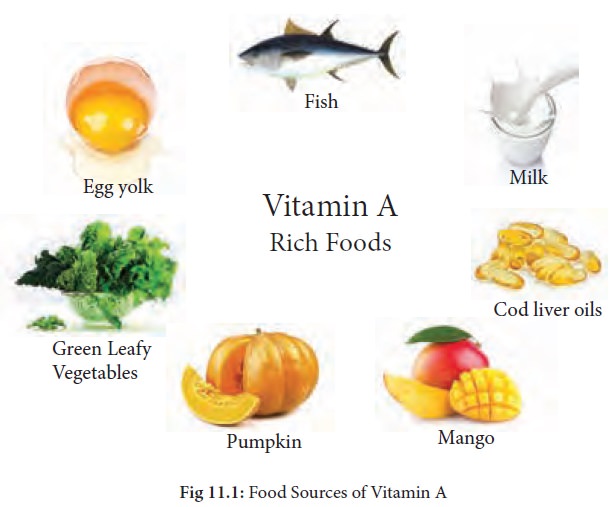Chapter: 11th Nutrition and Dietetics : Chapter 11 : Vitamins, Minerals and Water
Vitamin A : Functions, Food Sources, Symptoms of deficiency
Vitamin A
Vitamin A was discovered in 1909 and its chemical name is retinol. The vitamin A compounds include retinol, retinal and retinoic acid. It has a specific function in the retina of the eye. Vitamin A occurs only in foods of animal origin. Vitamin A activity is possessed by carotenoids found in plants. Hence carotenoids are called provitamin A.
Functions
· It provides the required stimulation for vision in the retina and is essential for maintaining normal vision.
·
It helps in maintaining healthy skin and epithelial tissues.
·
It is important for proper growth of bones.
·
It helps in normal foetus development.
·
It protects the mucous membrane of the digestive, respiratory
and urinary tracts against infection.
Food Sources of Vitamin A
Vitamin A is present
as retinol in animal sources such as egg yolk, fish (halibut, shark, cod),
liver and cod liver oils. In plants, it is found in the form of carotene which
gets converted to vitamin A in the body. Carrot, beetroot, turnip, papaya,
mango, pumpkin, tomatoes, green leafy vegetables, drumsticks, whole milk,
butter, ghee etc., are very good sources of carotene.

Symptoms of Vitamin A deficiency
1. Night blindness: This is also called as
Nyctalopia. Initially there is itching, burning and inflammation of eyelids and
the person gradually loses vision to see in the dim light.
2. Keratomalacia: This occurs due to
poor intake or poor absorption of vitamin A. When conjunctival xerosis is not
treated it may develop into a condition known as keratomalacia. Cornea becomes
dull.
3. Xeropthalmia: This occurs in which the eyes become thickened, wrinkled and extremely dry followed by progressive cloudiness. This is due to keratinisation of the epithelial cells over the cornea. This condition is extremely common among all age groups in India and other developing countries where the vitamin A intake is low.
4. Bitot’s spot: Silver grey foamy
deposits on the delicate membranes covering the whites of the eyes. Softening
of the corneas may lead to corneal infection, perforation and degenerative
tissue changes, which may result in blindness.
5. Skin becomes rough,
dry and scaly. This condition is known as toad’s skin.

Related Topics